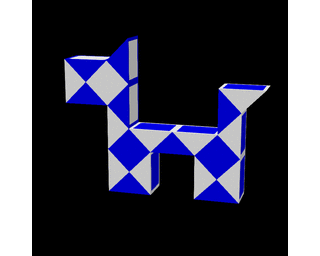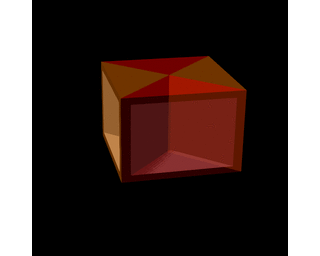The Rubik's Snake (or Rubik's Twist) is a toy consisting of several triangular prisms strung together in a line in such a way that the pieces can be rotated about one another in 90 degree turns.
Any snake can be described by an ordered sequence of rotations (format described below). Some sequences do not describe physically possible, "valid", snakes because they would cause the pieces to self-intersect. Some sequences describe "cyclic" snakes, which happens when the open square faces of the first and last piece of the snake meet.
Given a sequence of rotations, your task is to output whether the snake is "valid" and output whether the snake is "cyclic".
Input
A sequence of length n-1 describes a snake with n pieces. The index of the sequence describes the state of the interface between two pieces at that index, i.e., how those two pieces are rotated. Any alphabet with 4 letters can be used to describe the possible rotations.
Here we will use:
0- No rotation1- 90 degree rotation2- 180 degree rotation3- 270 degree rotation
Note that this implies some chirality. For the demos below I use a left-hand rule but the choice is arbitrary as long as you are consistent.
Here are some basic examples:
00000000000 - A straight, unfolded Rubik's Mini Snake (12 pieces)
0220 - A simple 5 piece snake
11111111111111111111111 - A Rubik's Snake (24 pieces) consisting only of 90 degree clockwise turns
13131 - A "cyclic" snake that mixes clockwise and counterclockwise turns
20220200022020020220002 - A classic Rubik's Snake dog design without symmetry
222 - The shortest "cyclic" snake
13133311131333111313331 - A more elaborate "cyclic" design on the Rubik's Snake
0022200 - Not a "valid" snake because it self-intersects
00031310000 - A more elaborate invalid snake
0003131000313 - Snakes which are not "valid" may still be "cyclic"
2222222 - Another invalid snake which is still "cyclic" (deceptively similar to 222, which is valid)
The first image is the "Twin Peaks" pattern as found on Wikipedia (the pattern was found there, the images here are my original work). It is described by 10012321211233232123003 and is both "valid" and "cyclic".
Finally, a bonus 240 piece Rubik's Snake (yes, they actually sell these) 01113133131131331311313330020013000000310000003100000013000000130022031000013211001302020031002203100001300001300003121102022011001300130031001300310031001121300003323100000013211000031000031000220000130000003100000031002022022031233213002
Caveats
- By default, the input is a string consisting of
0s,1s,2s, and3s - Must be able to handle all sequences of length 3 or greater (n >= 4)
- If it is more practical or golf-able to handle a list of characters or a list of integers 0 thru 3, you may do so as long as it is consistent. Just be sure to specify in your answer.
Output
Given a sequence as described above, your program should ouput whether the sequence describes a snake that is:
- "valid" and "cyclic" (
[true, true]) - "valid" but not "cyclic" (
[true, false]) - not "valid" but "cylcic" (
[false, true]) - not "valid" and not "cyclic" (
[false, false])
Caveats
The format of your output need not be exactly [bool, bool], as long as:
- There are exactly 4 possible outputs
- Each possible output uniquely corresponds exactly 1-to-1 with
[true, true],[true, false],[false, true],[false, false]for[valid, cyclic] - Your chosen format is consistent for each input
- Standard loopholes. Ask for clarification in comments
For example, if you want your outputs to be "alice", bob, 37, [], you may do so as long as you specify what that means in your answer.
Examples
INPUT=====================+=OUTPUT==========
Sequence | Valid | Cyclic
==========================+========+========
00000000000 | true | false
0220 | true | false
11111111111111111111111 | true | false
13131 | true | true
20220200022020020220002 | true | false
222 | true | true
13133311131333111313331 | true | true
0022200 | false | false
00031310000 | false | false
0003131000313 | false | true
2222222 | false | true
10012321211233232123003 | true | true
| |
0111313313113133131131333 | |
00200130000003100000031 | |
00000013000000130022031 | |
00001321100130202003100 | |
22031000013000013000031 | true | true
21102022011001300130031 | |
00130031003100112130000 | |
33231000000132110000310 | |
00031000220000130000003 | |
10000003100202202203123 | |
3213002 | |
==========================+========+========
This is code-golf, so shortest answer wins!














